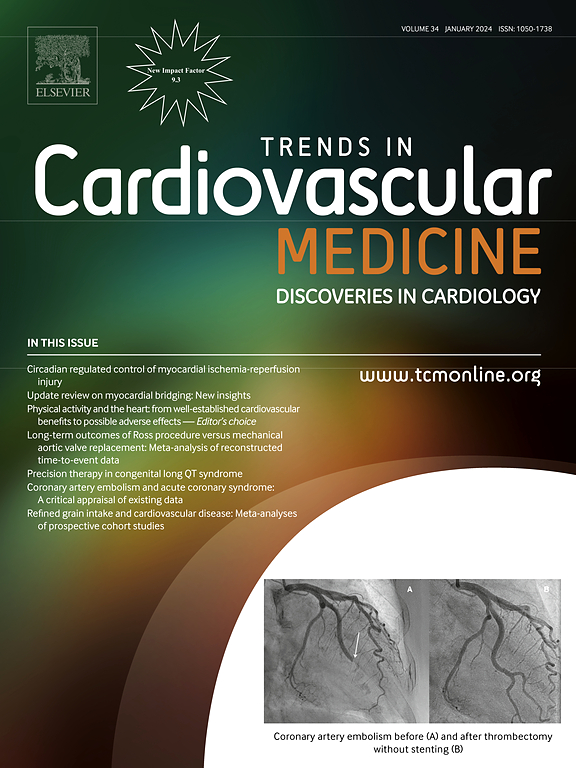Uncovering the role of prokineticin pathway on Epicardial Adipose Tissue (EAT) development and EAT-associated cardiomyopathy
IF 9
2区 医学
Q1 CARDIAC & CARDIOVASCULAR SYSTEMS
引用次数: 0
Abstract
Epicardial adipose tissue (EAT), a unique fat depot surrounding the heart, plays a multifaceted role in glucose and lipid metabolism, thermogenesis, and the secretion of bioactive molecules that influence cardiac structure and function. Its proximity to the myocardium allows it to contribute directly to CVDs, including coronary artery disease, arrhythmias, and heart failure. In particular, excessive EAT has emerged as a significant factor in heart failure with preserved ejection fraction (HFpEF), the most common form of heart failure, especially in individuals with obesity and diabetes. Traditional metrics like body mass index (BMI) fail to capture the complexities of visceral fat, as patients with similar BMIs can exhibit varying CVD risks. EAT accumulation induces mechanical stress and fosters a pro-inflammatory and fibrotic environment, driving cardiac remodeling and dysfunction.
Pharmacological modulation of EAT has shown promise in delivering cardiometabolic benefits. Recent advancements in diabetes therapies, such as SGLT2 inhibitors and GLP-1 receptor agonists, and antilipidemic drugs have demonstrated their potential in reducing pro-inflammatory cytokine production and improving glucose regulation, which directly influences EAT. These discoveries suggest that EAT could be a significant therapeutic target, though further investigation is necessary to elucidate its role in HFpEF and other CVDs.
Recent advances have identified the prokineticin/PKR1 signaling pathway as pivotal in EAT development and remodeling. This pathway regulates epicardial progenitor cells (EPDCs), promoting angiogenesis while reducing EAT accumulation and metabolic stress on the heart, particularly under high-calorie conditions. Prokineticin, acting through its receptor PKR1, limits visceral adipose tissue growth, enhances insulin sensitivity, and offers cardioprotection by reducing oxidative stress and activating cellular survival pathways. In this review, we provide a comprehensive analysis of EAT's role in CVDs, explore novel therapeutic strategies targeting EAT, and highlight the potential of prokineticin signaling as a promising treatment for HFpEF, obesity, and diabetes.
揭示促激肽通路在心外膜脂肪组织 (EAT) 发育和 EAT 相关心肌病中的作用
心外膜脂肪组织(EAT)是心脏周围独特的脂肪库,在葡萄糖和脂质代谢、产热以及影响心脏结构和功能的生物活性分子的分泌中起着多方面的作用。它靠近心肌,直接导致心血管疾病,包括冠状动脉疾病、心律失常和心力衰竭。特别是,过度进食已成为保留射血分数(HFpEF)心力衰竭的重要因素,这是最常见的心力衰竭形式,特别是在肥胖和糖尿病患者中。像身体质量指数(BMI)这样的传统指标无法捕捉到内脏脂肪的复杂性,因为具有相似BMI的患者可能表现出不同的心血管疾病风险。EAT的积累诱导机械应力,促进促炎和纤维化环境,驱动心脏重塑和功能障碍。对EAT的药理学调节在提供心脏代谢益处方面显示出了希望。糖尿病治疗的最新进展,如SGLT2抑制剂和GLP-1受体激动剂,以及降脂药物已经证明了它们在减少促炎细胞因子产生和改善葡萄糖调节方面的潜力,这直接影响了EAT。这些发现表明EAT可能是一个重要的治疗靶点,尽管需要进一步的研究来阐明其在HFpEF和其他心血管疾病中的作用。最近的进展已经确定prokineticin/PKR1信号通路在EAT的发育和重塑中起关键作用。该途径调节心外膜祖细胞(EPDCs),促进血管生成,同时减少EAT积累和心脏代谢应激,特别是在高热量条件下。促运动素通过其受体PKR1起作用,限制内脏脂肪组织的生长,增强胰岛素敏感性,并通过减少氧化应激和激活细胞存活途径提供心脏保护。在这篇综述中,我们全面分析了EAT在心血管疾病中的作用,探索了针对EAT的新治疗策略,并强调了促运动素信号作为HFpEF、肥胖和糖尿病的治疗方法的潜力。
本文章由计算机程序翻译,如有差异,请以英文原文为准。
求助全文
约1分钟内获得全文
求助全文
来源期刊

Trends in Cardiovascular Medicine
医学-心血管系统
CiteScore
18.70
自引率
2.20%
发文量
143
审稿时长
21 days
期刊介绍:
Trends in Cardiovascular Medicine delivers comprehensive, state-of-the-art reviews of scientific advancements in cardiovascular medicine, penned and scrutinized by internationally renowned experts. The articles provide authoritative insights into various topics, encompassing basic mechanisms, diagnosis, treatment, and prognosis of heart and blood vessel disorders, catering to clinicians and basic scientists alike. The journal covers a wide spectrum of cardiology, offering profound insights into aspects ranging from arrhythmias to vasculopathies.
 求助内容:
求助内容: 应助结果提醒方式:
应助结果提醒方式:


